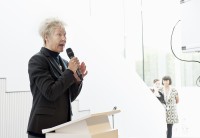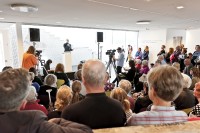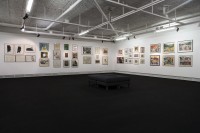Art of the strike

Bildmuseet 2012
Since 2010, I have been working with my investigation “What happened with the art of the strike?” where I have examined The Great Miners’ Strike of 1969/70 in Sweden and its relation to the general radicalization of the artistic and cultural landscape in the wake of the 1968 uprising. The project has taken various forms in which I have worked with archival materials from the time of the strike. I have shown the project at: ArkDes (2020), Rutiga Golvet, Royal Art Academy (2017), Kunsthaus Dresden (2014), Tensta Konsthall (2013), Norrbottens museum (2013) and Bildmuseet (2012). I have also staged this material as theatre; organized “Witness seminars” in collaboration with Södertörn University in Stockholm and written the book “The art of the strike, voices on cultural and political work during and after the mining strike 1969-70” (Glänta)
In December 1969, a wildcat strike broke out in the iron ore fields in Norrbotten, the far north of Sweden. Despite the fact that it was a record year for Sweden and that the state-owned mining company LKAB made a profit, the working conditions of the miners became worse. The strike spread from Kiruna to Svappavaara and Malmberget and after a few days, involved some 5,000 miners. Through NLF (National Liberation Front/Vietnam) and other local political groups, many people working in culture expressed solidarity with the miners and engaged themselves in their situation. What happened with the art of the strike? is about the wildcat strike–which can be seen as one of the first major cracks in the facade of the welfare state–and the effects it had on the cultural life. The project encompasses various investigations of the strike, and these are materialized in different ways. One is an exhibition of the Gruvarbetarnas strejkkonstsamling (The Miners’ Strike Art Collection), the largest part of which was shown at Tensta konsthall 2013 and Bildmuseet, 2012. The collection consists of some one hundred artworks which were donated by artists in support of the strike fund.Among the artists who donated work were Albin Amelin, Siri Derkert, Lars Hillersberg, and Berta Hansson. At present, the collection is under the auspices of the municipal Gällivare Museum. The project also contains edited archive material, a series of photographs and dramatizations based on strike documents.
Various social and political groups were active all over Sweden to collect money for the miners’ strike fund when they did not get strike support from LO (The Swedish Trade Union Confederation). Several initiatives were taken on by the arts and culture scene to organize art auctions and fundraisers for the strikers including by Sundsvall Museum, Stockholm Concert Hall, Moderna Museet and Gallery Heland. The art works which were shipped to Malmfälten were nevertheless not sold. Instead, after the strike, they were spread out and stored on different premises such as ABF (Workers’ Educational Association), Gruv 4:an (4th Mine), and Folkets Hus in Malmberget. Over the years, the collection has been managed by the strike committee members and the local mining union, Gruv 4:an, in Malmberget, but since 2009 it has been stored at Gällivare Museum. The collection is owned by the miners at LKAB.

Bildmuseet 2012

Tensta Konsthall, 2013

Bildmuseet 2012